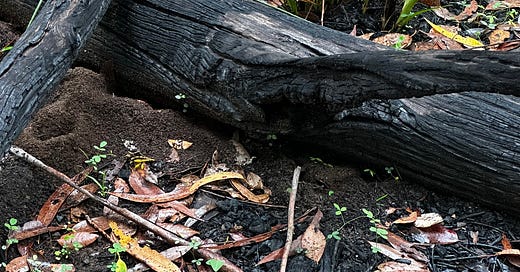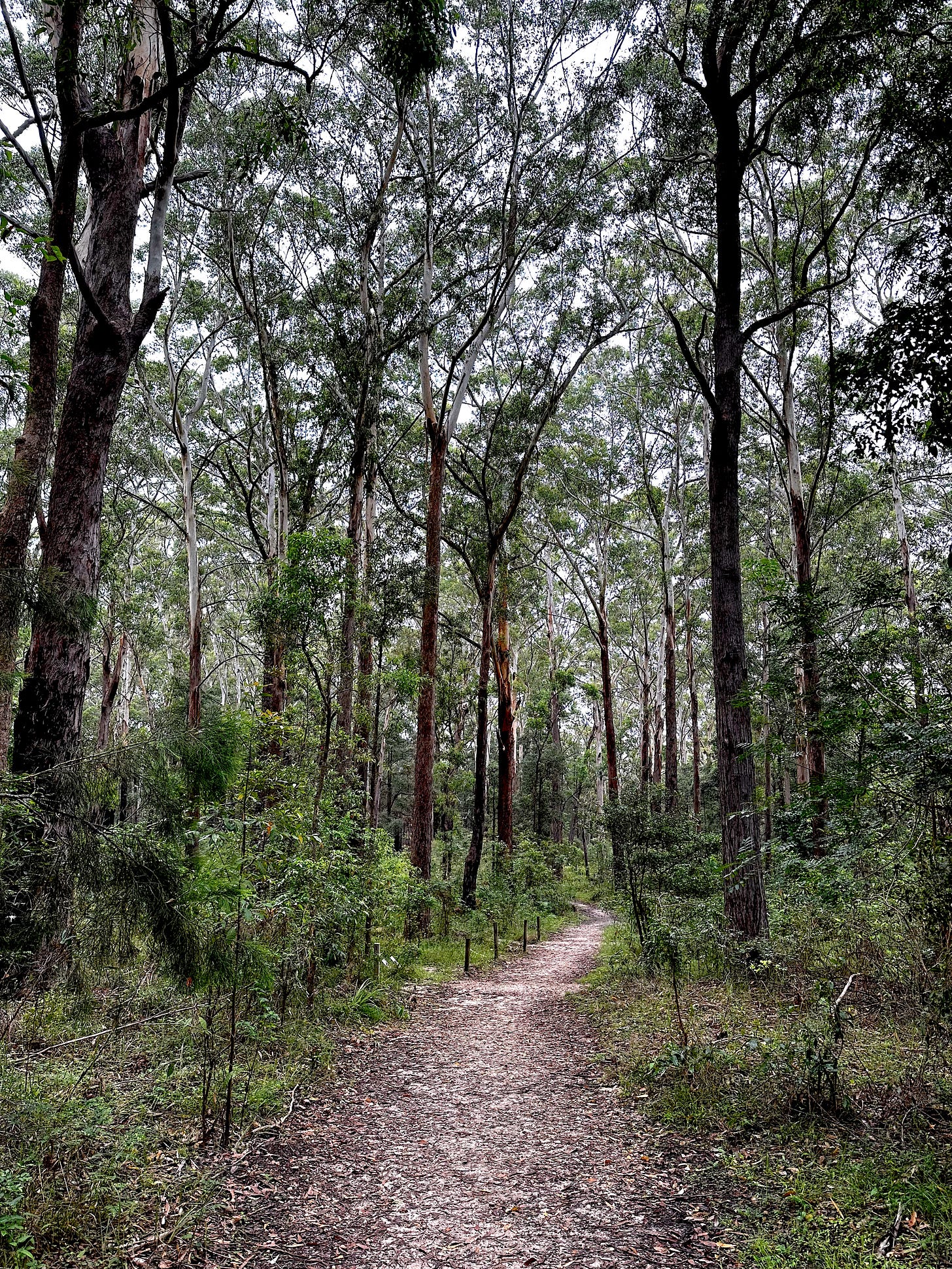What is a BAL and should I be afraid?
Normanhurst, as regular readers will know, is a bushy suburb in Sydney’s upper North Shore. Wikipedia will tell you if you look it up: ‘Most of the North Shore suburbs are part of the Hornsby Plateau, a large sandstone plateau overlaid by a system of ridges and gullies. The Plateau begins north of the Port Jackson and runs up until the Hawkesbury River. Thus much of the North Shore is hilly with many steep valleys running down into the harbour and the rivers on either side.’
And those steep valleys are full of bush.
Acronyms for our times
I provide this geographical background because it’s relevant to a subject recently brought to my attention: the BAL rating for a block of land in this lovely region. As I’ve quickly discovered, building—like many aspects of modern life—is awash with acronyms. ‘BAL’ seemed yet another of these, like BASIX or HRV or MVHR and so on—something I could leave to the professionals. But certain tell-tale signs soon indicated that I should be paying more attention to this BAL thing.
The first was a request from one of my new neighbours. ‘We have organised a fire assessment’ they said. Then something about ‘affects our BAL rating’ and ‘the management of the APZ’.
Next, advice from my architect son. ‘Your block has the highest BAL,’ he informed me. ‘There’ll be a 20-metre exclusion zone.’
I looked up APZ: ‘Asset Protection Zone’: managing the area to reduce bushfire risk. The ‘Asset’ in ‘Asset Protection Zone’ means … my house-to-be.
The NSW Rural Fire Service has plenty to say about these things. I found a comprehensive document filled equally with helpful diagrams and dire warnings.
Plus a new acronym: PBP —Planning for Bushfire Protection.
Fire in the forest—due to controlled burning in this case.
What is my block’s BAL?
Eventually I discovered what the acronym ‘BAL’ actually stands for: Bushfire ATTACK Level!
Attack? The whole issue was starting to sound like a pitched battle. Me and my house against the elements. Which, if you think seriously about bushfires, is pretty much accurate.
The NSW Rural Fire Service website has an online tool for looking up the bushfire risk of your home or land. I entered the address of my block and received this result:
Slightly freaking out by now, I investigated further and found this table of BAL levels:
Is the risk at my block BAL—29? BAL— 40? The dreaded BAL—FZ??
‘FZ’= ‘FLAME ZONE!
I haven’t yet delved as fully as I inevitably must, but it seems that building on the land will make a difference to the final BAL. When my neighbours build on their blocks—and I on mine—this will somewhat reduce the risk of a renegade fire sweeping through. But behind the blocks is a stand of protected bushland (a fragile species or two in there, I think).
Being Australia, and being the upper North Shore of Sydney, this will all have to be properly handled. I remembered that Passivhaus in Asquith with the outside sprinkler system. That began to look like a good idea.
Regulations
Give the bushfire ATTACK level, any building we design will have to meet stringent criteria from the relevant authorities. As the NSW RFS advises: ‘You will need to think about the kind of house you want, as well as the bush fire protection measures for your home… This process usually takes a considerable amount of time and involves a lot of detail.’ Indeed.
Obviously I’m keen to build a house which won’t burn down. This will mean fire-resistant materials throughout the building, keeping the landscaping fire-resistant, complying with the ‘exclusion zone’ and any other recommendations, ensuring a well-sealed house to prevent embers entering if a fire roars through that bush at the back. There will need to be plenty of water available in tanks, with a pump, and access for fire truck.
I find myself imagining a bushfire Armageddon.
It’s happened.
In the 1980s, newly married, we built a house at Winmalee in the Blue Mountains. We lived in it for a few years before selling and moving to the city. In October 2013, sitting in a pasticceria in Amalfi, Italy, I scrolled the Australian news stories and paused, appalled, at a photograph of that same house. It had been burnt to a ruined husk in the bushfires which devastated that area of the Mountains that year. Though I hadn’t lived in the house for three decades, the loss felt strangely close. I’d raised my children in that house. Our neighbours from those days, too—many lost their long-time homes.
So I know that living in or near the Australian bush is not something to be undertaken lightly.
Winmalee, 2013. The shocking photo. [source]
What about that bush?
Hornsby Shire has two kinds of bush: Blue Gum High Forest (also called wet sclerophyll forest) and Sydney Turpentine-Ironbark Forest, and the survival of both is threatened by weeds, stormwater, dumping, clearing, and disease.
These forests are also the habitat for several threatened species, including the Glossy Black Cockatoo, the Swift Parrot, Powerful Owl, Grey-headed Flying Fox and the Yellow-bellied Sheath tail bat.
I imagine these critters living precariously in that bush behind my new house. I learn that three tree species are common components of Blue Gum High Forest, the Blackbutt, the Sydney Blue Gum and the beautiful Angophoras (also called smooth-barked apple).
Sheldon Forest, Turramurra
In my neighbourhood: Sheldon Forest
Sheldon Forest is at the end of my street in Turramurra, three minutes’ walk from my front door. It’s a remnant of Blue Gum High Forest, where Blackbutt is the dominant species. Less than one percent of this forest type remains in Sydney. In this report from 2014, Ku-ring-gai Council was trying to save the remnant forest from weed invasion.
‘Council staff have already spent several months eradicating invasive weeds such as morning glory from 2500 square metres of the Sheldon Forest Creek area in the reserve at the end of Warragal Road, Turramurra.
This is a beautiful, small reserve just off the Pacific Highway south of Turramurra, running between the top end of Warragal Road and Troon Place alongside Avondale Creek. Descending rapidly along the creek, the track meanders through the beautiful bushland of Sheldon Forest, along ridge tops, through open forest on the hill slopes and down to the creek side. Sheldon Forest is of high conservation status because it contains some of the last remnants of the endangered ecological communities Sydney Turpentine Ironbark Forest and Blue Gum High Forest.’
According to signage at the Forest, work goes on, including weed removal and regular controlled burns.
Turramurra and trees
Here in Turramurra, I’m surrounded by some of the tallest trees I’ve ever seen, let alone lived amongst. In the front garden of this 1955 Henry Epstein house is a tree so tall you can hardly see the top, with a girth of more than four metres (I measured, roughly). I think it’s a Sydney Blue Gum, but correct me if you’re an expert.
The Turramurra tree.
Every morning the dawn chorus of birds here is delightfully noisy and vivacious (there’s also a local rooster who joins in). Most days the metal roof of the house resounds to the dropping of leaves, small branches and other tree debris. I was given a leaf blower for Christmas and use it regularly. On most Saturday mornings, the air of South Turramurra fills with the roar of leaf blowers.
We live with the trees.
Better come up with a fire-proof strategy.
Staring faaaaaar up into the Turramurra tree












The photo looking up the Turramurra Tree is fantastic!